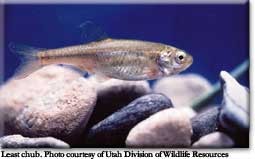 Many of the Mitigation
Commission’s projects benefit native fish (native fish species are
included in the Sensitive Species Inventory listed in Utah Division of
Wildlife Resources' Utah Conservation Data Center web
page.) The Mitigation Commission also has projects specifically for
native fish. These include: June sucker recovery, native cutthroat
trout, native fish studies and the warm-water and native aquatic
species culture facility. Many of the Mitigation
Commission’s projects benefit native fish (native fish species are
included in the Sensitive Species Inventory listed in Utah Division of
Wildlife Resources' Utah Conservation Data Center web
page.) The Mitigation Commission also has projects specifically for
native fish. These include: June sucker recovery, native cutthroat
trout, native fish studies and the warm-water and native aquatic
species culture facility.
The Mitigation Commission signed Conservation
Agreements developed under the Endangered Species Act for least chub,
Bonneville cutthroat trout and Colorado River cutthroat trout. These agreements
were developed by natural resource agencies and interested public.
The Commission has provided funding for native
cutthroat trout conservation since 1995. This funding has been used to
identify native remnant cutthroat populations that could be used for
starting new populations to meet conservation agreement goals. This
identification is done by analyzing suspected cutthroat trout
populations’ genetic and physical characteristics and by evaluating
past stocking records for waters they inhabit.
The US Fish and Wildlife Service issued a finding
of listing not warranted for the Bonneville Cutthroat Trout in response
to a petition for listing the fish as endangered. Work completed under
the Bonneville cutthroat trout conservation agreement provided the basis
for this finding.
To aid least chub conservation agreement measures,
the Mitigation Commission is acquiring properties in a natural spring
area west of Mona in Juab County, Utah. The area supports spotted frog,
least chub and California floater (mollusk). Acquiring this property
will result in the protection and continued survival of the only known
population of least chub along the Wasatch Front, and will preserve
habitat for many other aquatic species, particularly spotted frog.
Acquiring and protecting this habitat is a vital component toward
assuring conservation of these species along the Wasatch Front.
A proposed native aquatic species and warm-water sport-fish hatchery in Utah will aid
conservation and recovery of several native aquatic species. Native
fish needs identified for the warm-water and native aquatic species
culture facility include production numbers for June sucker, least
chub, leatherside chub, roundtail chub and flannelmouth sucker. Two
amphibian species are included as well: spotted frog and boreal toad.
Details on these production needs are listed in the Fish Hatchery Production Plan.
In addition to this facility, native Colorado River cutthroat trout are
planned to be reared at the proposed Big Springs Ute Tribe Fish
Hatchery.
Leatherside chub conservation is also a mitigation commitment of the Utah Lake Drainage Basin Water Delivery System (ULS), the final component of the Bonneville Unit of the Central Utah Project.On March 1, 2011 a scoping notice was issued asking for public input on the need to construct a fish barrier in Main Creek, a Provo River tributary that runs through Wallsburg, Wasatch County, Utah. Main Creek and its tributaries are home for native aquatic species, including Bonneville Cutthroat Trout and Southern leatherside chub. The Southern leatherside chub population within Main Creek is the only significant population within the Provo River drainage and has been identified as one of the most genetically distinct. Native fish habitat in Main Creek basin is highly fragmented by diversion structures, impassible culverts, and seasonally dewatered reaches. Predation, competition and hybridization with nonnative fish impact the unique native fish community in Main Creek. To prevent movement of nonnative fish from Deer Creek Reservoir into this area, it was determined that installation of a fish barrier was needed. A preferred location has been identified and public input is being solicited to identify possible issues and impacts with constructing the barrier there. [Click here to download the public scoping document]
Some native fish species have also benefitted from
the Provo River Restoration Project.
Fish sampling surveys indicate that seven native fish species exist in
the Provo River Restoration Project area. These are mottled sculpin,
mountain whitefish, Utah sucker, longnose dace, speckled dace, mountain
sucker and redside shiner. Off-channel habitats, such as ponds and old
channel cutoffs, support native fish species. These habitat types are
important for these populations and are included in the river
restoration project planning.
The Provo River Restoration Project baseline
monitoring 2000 report for native fish, prepared by M. Belk and C.
Ellsworth, BYU is available by contacting the Commission.
|